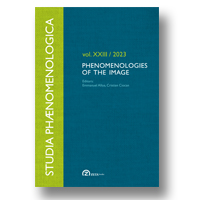|
21.
|
Studia Phaenomenologica:
Volume >
6
David Grandy
Merleau-Ponty’s Visual Space and the Law of Large Numbers
abstract |
view |
rights & permissions
| cited by
Maurice Merleau-Ponty argued that the seeing of things together (focal figure and background objects) accounted for the sense that things possess unseen depth: they are three-dimensional entities, not facades. I compare this idea to the law of large numbers. In both cases, single entities take on substance, depth, or meaning when assimilated into a large body of comparable instances. Thinking along these lines, Erwin Schrödinger proposed that living processes achieve order by virtue of the multiplicity of their constituent parts, any of which, when considered individually, militate against perception and understanding. He further suggested that those parts take their place as things to be perceived even as they constitute our perceiving faculties, and this is why uncertainty occasions their reality. Thus he offers an instance of Merleau-Ponty’s notion of chiasmic intertwining, which allows for world-body interchange or reversibility beyond the reach of unequivocal apprehension.
|
|
|
22.
|
Studia Phaenomenologica:
Volume >
6
Caroline Guibet Lafaye
Arts postmodernes, philosophie du langage et phénoménologie
abstract |
view |
rights & permissions
| cited by
The identification of a post-modern art requires the determination of its implicit patterns of signification, as is the case with the modern art’s patterns of signification. In fact, the mere formal and stylistic analyses are not able to distinguish the post-modern art from the modern art. Actually, the specificity of minimalist and post-minimalist sculpture is founded on a phenomenological interpretation of subjective aesthetic experience (the reciprocal glance between who regards and what is regarded) and on a phenomenological interpretation of significance. In other words, this phenomenological interpretation gives a positive content to the concept of post-modern art.
|
|
|
23.
|
Studia Phaenomenologica:
Volume >
6
Tinca Prunea-Bretonnet
L’individuation par l’amour:
Le phénomène érotique de Jean-Luc Marion
abstract |
view |
rights & permissions
| cited by
This review-article aims to present the inner structure of J.-L. Marion’s book of 2003, Le phénomène érotique. Although closely related to the former development of the phenomenology of donation, his analysis of the concept of love discloses significantly new philosophical elements as it shows the pre-eminence, own rationality and univocity of this concept. My paper basically takes into account the question of the individuation of the other and of the self within the saturated phenomenon of love. I discuss the coherence and conceptual consistency of its “figures” and description. I also try to suggest the possibility to question further in the direction of God as “the third” who grants or attests the individuation of the lovers in a unique common erotic phenomenon. Eventually, I claim that his overwhelming importance might affect the “two-entrance” phenomenon of love and the definition of the lover whose figure he is supposed to assume in his manifestation.
|
|
|
24.
|
Studia Phaenomenologica:
Volume >
6
Tracy Colony
Unearthing Heidegger’s Roots:
on Charles Bambach’s Heidegger’s Roots
abstract |
view |
rights & permissions
| cited by
Charles Bambach’s recent book Heidegger’s Roots: Nietzsche, National Socialism, and the Greeks traces the themes of rootedness and the earthly in Heidegger’s thought. Focusing on the role of these themes in the major works of the 1930’s, Bambach offers an account of Heidegger’s relation to contemporaneous conservative and National Socialist ideologies. In this review article, I question the fundamental presupposition guiding Bambach’s approach and present specific reservations regarding his use of untranslated material from Heidegger’s Nietzsche lecture courses.
|
|
|
25.
|
Studia Phaenomenologica:
Volume >
6
Book Reviews
abstract |
view |
rights & permissions
| cited by
Claire Katz & Lara Trout (ed.), Emmanuel Levinas. Critical Assessments of Leading Philosophers (Tomáš Tatranský); Thomas Bedorf, Andreas Cremonini (Hrsg.), Verfehlte Begegnung. Levinas und Sartre als philosophische Zeitgenossen (Sophie Loidolt); Samuel Moyn, Origins of the Other: Emmanuel Levinas between Revelation and Ethics (Eric Sean Nelson); Pascal Delhom & Alfred Hirsch (Hrsg.), Im Angesicht der Anderen. Levinas’ Philosophie des Politischen (Sophie Loidolt); Sharon Todd, Learning from the other: Levinas, psychoanalysis and ethical possibilities in education (Lawrence Petch); Michel Henry, Le bonheur de Spinoza, suivi de: Etude sur le spinozisme de Michel Henry, par Jean-Michel Longneaux (Rolf Kühn); Jean-François Lavigne, Husserl et la naissance de la phénoménologie (1900-1913). Des Recherches logiques aux Ideen: la genèse de l’idéalisme transcendantal phénoménologique (Yves Mayzaud); Denis Seron, Objet et signification (Denisa Butnaru); Dan Zahavi, Sara Heinämaa and Hans Ruin (eds.), Metaphysics, Facticity, Interpretation. Phenomenology in The Nordic Countries (Andreea Parapuf); Dimitri Ginev, Entre anthropologie et herméneutique (Jassen Andreev); Magdalena Mărculescu-Cojocea, Critica metafizicii la Kant şi Heidegger. Problema subiectivităţii: raţiunea între autonomie şi deconstrucţie (Adrian Niţă).
|
|





